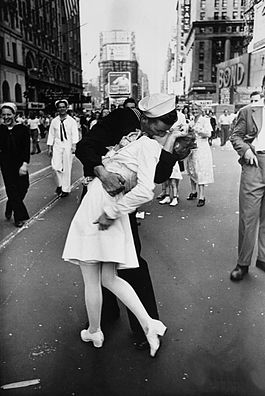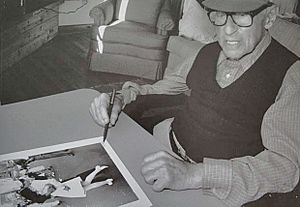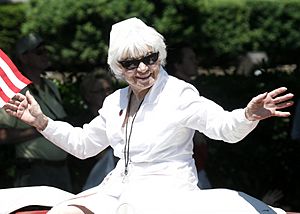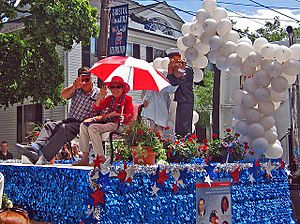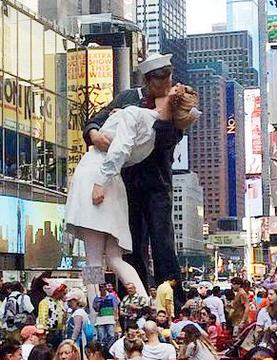V-J Day in Times Square facts for kids
V-J Day in Times Square is a very famous photograph. It was taken by Alfred Eisenstaedt. The picture shows a U.S. Navy sailor kissing a woman. She was a dental assistant. This happened on Victory over Japan Day ("V-J Day"). This day was August 14, 1945. The celebration took place in New York City's Times Square.
The photo was published a week later. It appeared in Life magazine. It was part of a big section about celebrations. These celebrations happened all over the United States. Eisenstaedt took the picture during a happy moment. People were waiting for the end of the war with Japan. President Harry S. Truman announced the war's end later that day.
Eisenstaedt said he took the photo quickly. He did not get the names of the people. Their faces are not clear in the picture. Many people have said they are the sailor or the woman. The photo was taken near 45th Street. It was where Broadway and Seventh Avenue meet. Experts believe it was taken around 5:51 p.m. Eisenstaedt used a Leica IIIa camera for this photo.
Contents
Alfred Eisenstaedt's Story
Alfred Eisenstaedt wrote about taking the photo. He shared his memories in two different books.
In Eisenstaedt on Eisenstaedt, he said:
In Times Square on V.J. Day I saw a sailor running along the street. He was grabbing and kissing every girl. It didn't matter if she was old or young. I was running ahead of him with my Leica. I was looking back over my shoulder. None of the pictures I took looked right. Then suddenly, I saw something white being grabbed. I turned and clicked when the sailor kissed the nurse. If she had worn a dark dress, I would not have taken the picture. If the sailor had worn a white uniform, the same. I took exactly four pictures. It happened in a few seconds. Only one picture is perfect. People tell me they will remember this picture when I am in heaven.
In The Eye of Eisenstaedt, he shared another version:
I was walking through the crowds on V-J Day. I was looking for pictures. I saw a sailor coming my way. He was grabbing every woman he could find. He was kissing them all. Then I saw the nurse in the huge crowd. I focused on her. Just as I hoped, the sailor came along. He grabbed the nurse and bent down to kiss her. If this girl hadn't been a nurse, if she'd worn dark clothes, I wouldn't have had a picture. The contrast between her white dress and the sailor's dark uniform makes the photo special.
His photograph became very famous right away. Eisenstaedt made sure he controlled how it was used. He allowed only a few copies to be made.
Victor Jorgensen's Photo
Victor Jorgensen was a news photographer for the U.S. Navy. He took another picture of the same scene. His photo was published in The New York Times the next day. Jorgensen called his photo Kissing the War Goodbye. It shows less of Times Square in the background. It does not clearly show the famous intersection.
Unlike Eisenstaedt's photo, Jorgensen's photo is in the public domain. This means anyone can use it. It was taken by a government employee on duty. Jorgensen's photo may not be as artistic. But it clearly shows where the kiss happened. It was in front of the Chemical Bank and Trust building. The Walgreens pharmacy sign is visible in the background.
A woman in Jorgensen's photo was identified. She is Kay Hughes Dorius from Utah.
Who Are the People in the Photo?
Life magazine first asked the people in the photo to come forward. No one replied. Years later, in 1980, Eisenstaedt got a letter. A woman said she was the one in the photo. This made the magazine ask the man to identify himself. Many people claimed to be the sailor. Surprisingly, more women also claimed to be the woman.
The Woman in the Photo
Greta Zimmer Friedman
Lawrence Verria and George Galdorisi wrote a book in 2012. It was called The Kissing Sailor. They studied the photo and interviewed people. They also talked to experts who study faces and bones. They decided the woman was Greta Zimmer Friedman. She was wearing her dental hygienist uniform.
Greta Friedman did not want to recreate the picture. She passed away in 2016 at age 92.
Edith Shain
Edith Shain wrote to Eisenstaedt in 1980. She said she was the woman in the photo. Her letter led Life magazine to ask for the man to come forward. Many people responded. Shain became well-known for her claim. She went to events about the photo. She also met men who said they were the sailor.
Edith Shain passed away in 2010 at age 91.
The 2012 book by Verria and Galdorisi said Shain could not be the woman. She was only 4 ft 10 in (1.47 m) tall. This height did not match any of the men who claimed to be the sailor.
The Man in the Photo
Many men have claimed to be the sailor. These include Donald Bonsack, John Edmonson, Wallace C. Fowler, Clarence "Bud" Harding, Walker Irving, James Kearney, Marvin Kingsburg, Arthur Leask, George Mendonsa, Jack Russell, and Bill Swicegood.
George Mendonsa
George Mendonsa was from Newport, Rhode Island. He was on leave from the USS The Sullivans (DD-537). He was watching a movie with his future wife, Rita Petry. This was at Radio City Music Hall. The doors opened and people started yelling. The war was over! George and Rita joined the celebration outside. They walked down the street. George then saw a woman in a white dress. He took her in his arms and kissed her. He said, "I considered her one of the troops—she was a nurse." In one of Eisenstaedt's four photos, Mendonsa claims Rita is visible behind them.
In 2005, a team from the Naval War College identified George Mendonsa. They said he was "the kisser." They matched his scars and tattoos to the photo. They used photo analysis by Mitsubishi Electric Research Laboratories. Richard M. Benson, a photo expert, also agreed. He said George Mendonsa was the sailor.
However, other scientists have questioned this. Donald W. Olson, Russell Doescher, and Steve Kawaler looked at shadows in the photos. They said the kiss happened after 5 p.m. Mendonsa's story said it was around 2 p.m. A clock in the photo also shows around 5:50 p.m. They concluded Mendonsa's timing was not right. George Mendonsa passed away in 2019 at age 95.
Friedman Identified by Mendonsa
Mendonsa and Friedman were interviewed many times. Mendonsa said Friedman was the woman he kissed. She was a dental assistant, but wore a white uniform like nurses did then.
Mendonsa Attended a War Memorial
A new painting was shown in 2013. It was called Victory Kiss by Jim Laurier. It honored the famous photo. George Mendonsa was there for the unveiling. This happened at Battleship Cove in Fall River, Massachusetts.
Carl Muscarello
Carl Muscarello was a retired police officer. He lived in Plantation, Florida. In 1995, he said he was the kissing sailor. He claimed he was in Times Square on August 14, 1945. He said he kissed many women that day. His mother identified him by a birthmark on his hand. Edith Shain first believed Muscarello. But in 2005, she was not sure. Muscarello said he did not clearly remember his actions that day. He believed it was him because his mother said so.
Glenn McDuffie
Glenn McDuffie claimed to be the sailor in 2007. Houston Police Department forensic artist Lois Gibson supported him. Gibson compared old photos of the sailor with new photos of McDuffie. She looked at his ears, facial bones, hairline, and hands. She said:
I could tell just in general that yes, it's him. But I wanted to be able to tell other people so I replicated the pose.
In 2007, McDuffie said he passed five polygraph (lie detector) tests. These tests confirmed his claim. McDuffie was from Kannapolis, North Carolina. He lied about his age to join the military at 15. After the war, he played semi-pro baseball. He also worked for the United States Postal Service.
McDuffie said he was going to Brooklyn by subway that day. He came out of the subway at Times Square. People were celebrating. He was excited because his brother was a prisoner of war in Japan. He knew his brother would be released. McDuffie started yelling and jumping. A nurse saw him and opened her arms. McDuffie said he ran to her and kissed her for a long time. He wanted Eisenstaedt to take the picture.
I went over there and kissed her and saw a man running at us...I thought it was a jealous husband or boyfriend coming to poke me in the eyes. I looked up and saw he was taking the picture and I kissed her as long as took for him to take it.
Lois Gibson also looked at photos of other men. She said their faces did not match the sailor in the photo. Glenn McDuffie was honored on his 81st birthday in 2008. This was at a Houston Astros baseball game. He was called the "Kissing Sailor." McDuffie passed away in 2014.
1980 Claims in Life
Life magazine published information about people claiming to be in the photo in October 1980. Carl Muscarello and Glenn McDuffie were not included. Their claims were made much later.
In Popular Culture
In 2005, John Seward Johnson II created a life-size bronze sculpture. It was called Unconditional Surrender. It was shown at a 60th-anniversary event in Times Square. Carl Muscarello and Edith Shain were there. They held a copy of the famous photo.
Johnson also made a 25-foot-tall (7.6 m) version. It was made of plastic and aluminum. This large statue was shown in several cities. These included San Diego and Sarasota. The 25-foot (7.6 m) statue was moved back to New York City in 2015 for a short time.
The photo has appeared in many movies and TV shows:
- In The Simpsons episode "Bart the General" (1990), a boy in a sailor outfit kisses Lisa Simpson. She then slaps him.
- In the film Night at the Museum: Battle of the Smithsonian (2009), characters jump into a giant version of the photo. One character kisses the nurse.
- The opening of the film Watchmen (2009) shows a superheroine kissing a female nurse. A photographer captures it.
- In the film Letters to Juliet (2010), the photo is shown. A magazine editor asks about its facts.
- In 2012, singer Katy Perry recreated the pose. She kissed a man on stage during a show for Marines.
- In the video game Wolfenstein: The New Order (2014), a different version of the kiss appears. It shows a Nazi soldier and a nurse in Paris.
|
See also
 In Spanish: V-J Day in Times Square para niños
In Spanish: V-J Day in Times Square para niños


